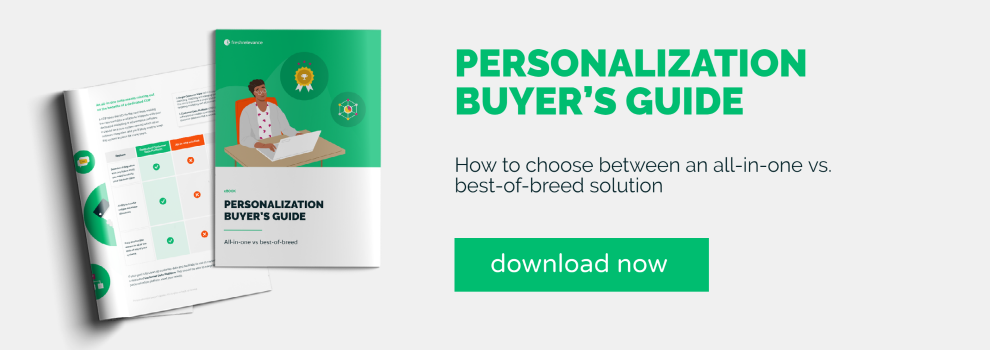What is personalization technology?
In eCommerce, personalization is when retailers and brands tailor the customer experience to each individual shopper based on contextual and behavioral data. Personalization tactics include dynamic content, product recommendations, triggered emails and more.
Personalization technology refers to the tools businesses use to fuel that personalization.
A typical personalization technology stack includes a best-of-breed personalization platform, email service provider (ESP), eCommerce system and customer data platform (CDP). But how your personalization tech stack looks will depend on your business needs.
With the world of eCommerce and technology changing rapidly, it’s important to understand personalization technology trends to help you select the best tools for your business.
Read on to discover 3 personalization technology trends for 2021.
Personalization technology trends for 2021
1) Personalization and data privacy
With increasingly disparate data sources, consumer concerns over privacy and a cookie apocalypse on the horizon, the best personalization technology is shifting with the times to future-proof their users’ identity strategies so they can continue to reap the benefits of personalization.
As consumers demand more choice, transparency and control over how their data is used for commercial and advertising purposes, the leading browsers have responded by increasingly restricting and blocking the use of cookies. Now the race is on among Firefox, Safari and Chrome to become the most privacy-friendly browser.
This means relying on third-party data to personalize the customer experience is a thing of the past, so buyers of personalization technology should steer well clear of platforms that rely on this type of data.
Instead, the best personalization technology uses a combination of zero-party data and first-party data to power personalization, as well as using both first-party cookies and unique identifiers to identify users.
Learn more: The personalization buyer’s guide to identity resolution
2) Personalization and AI
AI is no longer a buzzword. It is already commonly used in eCommerce to increase revenue with product recommendations based on the shopper’s unique interests, for example, and the increasing accessibility of AI in personalization technology is going to heighten the customer experience further. In fact, it is predicted that businesses will spend $7.3 billion on AI by 2022.
Some personalization technology also uses advanced AI techniques to personify the experience of visitors who have yet been identified, helping businesses tailor the customer experience to new visitors to their sites. An example of such AI functionality includes Fresh Relevance’s Price Affinity Predictor, a tool that allows businesses to identify the desired price point for new visitors who have not interacted with their website yet and display relevant product recommendations using those insights.
It’s increasingly important to provide tailored customer experiences, so buyers of personalization technology should look for tools that incorporate AI to help them give customers what they want.
3) Multi-channel personalization
More and more, consumers interact with eCommerce brands on a multi-channel basis, switching instinctively between emails, mobile apps, PWAs, social media and websites. In fact, Forrester research shows that consumers use more than four devices each day. And whilst many marketers think about channels separately, most consumers don’t think about channels at all. Instead, they expect a single cohesive experience that transcends channels.
So it’s important for businesses to give customers what they want and provide a consistent, tailored multi-channel experience.
The best personalization technology allows businesses to implement personalization that can be executed on different channels, for example helping them display consistent cross-channel personalized product recommendations based on browse and purchase data and cross-channel coupons targeted at specific segments.
Cosmetics and skincare brand Look Fabulous Forever uses behavioral targeting to ensure that any targeted offer a shopper sees on Facebook or via email are then reflected on the website. Read the full success story.
Tools such as Fresh Relevance’s Experience Management allow businesses to define customer experiences, assigning which customer should see the experience, the content they are shown and the channel it’s displayed on. With businesses increasingly deploying many pieces of content across multiple channels, tools such as Experience Management improve cross-channel cohesion and ensure consistent messaging across both website and email.
Choosing the right personalization technology for you
If you’re looking to get serious with eCommerce personalization, you’re in good company. 89% of digital businesses are investing in personalization. Why? Because personalization works. The average Fresh Relevance client making full use of the platform sees a 25% increase in sales.
But there are different paths to take towards implementing personalization into your tech stack or bringing your existing initiatives to the next level.
Download our Buyer’s Guide to Personalization to discover 4 key considerations when choosing the right solution for your personalization needs.







